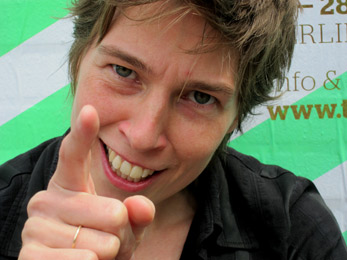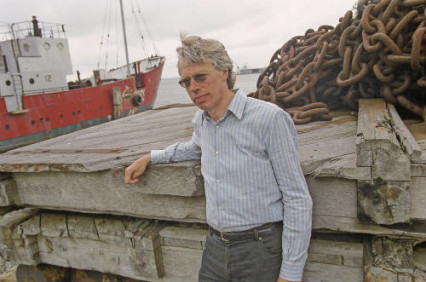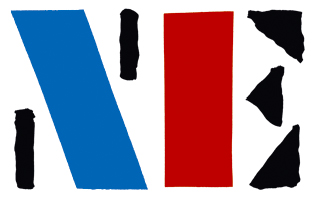Dora Stoutzker Hall, Royal Welsh College of Music and Drama, May 14 2015
Nieuw Ensemble, Conductor Ed Spanjaard
On a day when the equivalent of a month’s rain reportedly fell on Cardiff it was a relief to be able to seek refuge for an hour in the sunny sound world created by the Nieuw Ensemble. Following work with students of the RWCMD and a concert the previous night in Penarth, the Ensemble returned to the College for a lunchtime concert of bonnes bouches, six short pieces full of strong musical flavours.
In the programme note for her piece La Belle Chocolatière (2003), Dutch composer Mayke Nas says that it is named after a famous picture on a cocoa tin from 1900, in which an image is seen within an image, smaller and smaller, in the manner of a Russian doll. She says that her attempt to re-imagine a piece from Debussy’s Images -1 (1903) in that light is one which is bound to fail, but that ‘there is always a good reason for chocolate and systems are not meant to fit.’

Her words set the tone for this concert, one full of playful music which is never pretentious. Mayke Nas’s piece opens with the entire ensemble playing percussively, fashioning a texture into which she drops little fragments of melody, moving from instrument to instrument, each with their different tone-colour to contribute to the developing picture.
There was huge variety of instrumental timbre in the pieces included in this programme. Vale of Glamorgan featured composer Dobrinka Tabakova’s Frozen River Flows (2005) is a duet for oboe and percussion, an interplay of movement and stillness as in a river flowing below an ice covering. As resonance is enhanced when a glass strikes another, the sustained bell sounds of the crotales marry with the linear song of the oboe, and, with the underlay of the vibraphone, create a compellingly beautiful piece. An early use of crotales in the orchestra is Debussy’s tone poem Prélude à l’après-midi d’un faune (1894), where their combination with the flute obligato prefigures Tabakova’s piece.
Brazilian Rudofo Valente’s Inutensilio II (2009), scored for eight instruments, plays with unexpected sound combinations and explorations – wind instruments and guitar in conversation, passing over to strings with mandolin. As the composer himself notes, there is much to divert the musicologist in the piece, but one can simply ‘sit back and enjoy the listening.’ There is a particularly enjoyable little spat between the guitar and mandolin, as if the two of them are wondering about the curious company they are keeping in this ensemble! The inclusion of plucked instruments in the Nieuw Ensemble is one of its particular delights. (The harp is the third such, but is not included in this piece.)

Joël Bons played guitar in the Ensemble before becoming its Artistic Director in 1990. His Summer Dance (undated) is a virtuosic moment for clarinet and piano. In this performance the usually unobtrusive conductor of the Ensemble, Ed Spanjaard, showed his flamboyant side as the pianist. Here was another playful conversation in sound. After some rumbustious enchanges, the clarinet adopts a small, hesitant but rather charming voice as if to say ‘Excuse me, may I sit the next dance out?’
Richard Ayres’s composition No. 34b (2003), scored for violin, cello, flute, clarinet and percussion, was a piece of compelling subtlety. A technical problem with a CD player which refused to play gave an extra frisson to what was already a tense piece, featuring exaggerated inhalations and exhalations, foot shuffling and pointed looks from the players in ‘Waltz’, the first of its two movements. This was the ghost of a waltz, an imprint left when the dancers have left the room. The second movement, ‘Wallis (Chorale)’, was written in homage to fellow Cornishman, the fisherman painter Alfred Wallis (1855–1942). The missing sea sounds on the recalcitrant CD were replaced spontaneously by the players, something with which the composer declared himself happy. Perhaps he will amend the scoring accordingly!
The concert concluded with a piece from Alexandre Lunsqui, Drawings for Iberê (2009). This was inspired by a series of paintings called Spools by fellow Brazilian Iberê Camargo (1914–1994), which are abstractions of a charged object from the painter’s childhood, an empty spool of thread left from his mother’s sewing. Scored for nine instruments, the piece took us on a slightly crazy spooling journey, with additional sounds from inside the piano, swanee whistles, the crumpling of plastic bags and vocalisations from the players.
It was an additional pleasure to have four of the six composers featured in this concert – Tabakova, Valente, Bons and Ayres – present in the Dora Stoutzker Hall and able to acknowledge the clear delight in their work experienced by the audience. Although one should expect nothing less from professional musicians, every member of the Nieuw Ensemble played with exceptional commitment and flair. The whole concert was a joy. Furthermore I have discovered six composers from whom I would like to hear more, and been introduced to two painters as well.
Nieuw Ensemble: logo – and further information – at http://www.nieuw-ensemble.nl/home.html



 Enjoyed this article? Support our writers directly by buying them a coffee and clicking this link.
Enjoyed this article? Support our writers directly by buying them a coffee and clicking this link.







